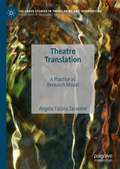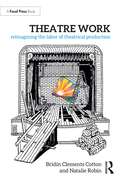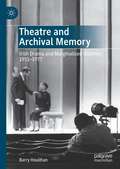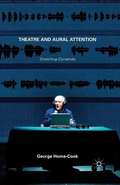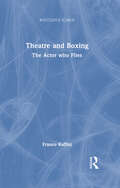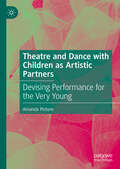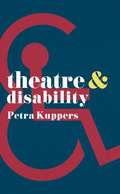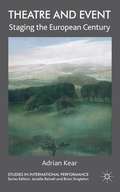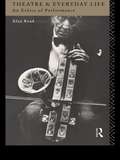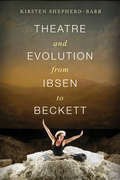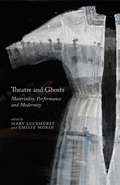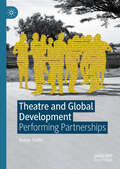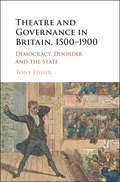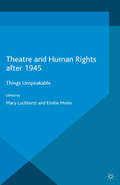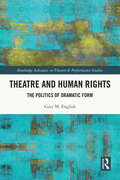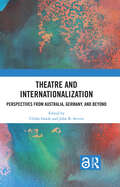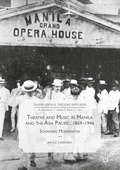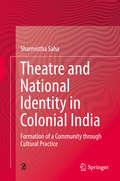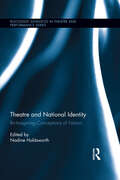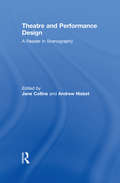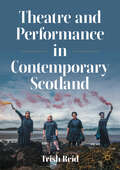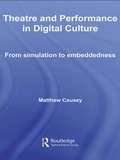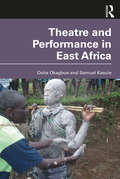- Table View
- List View
Theatre Translation: A Practice as Research Model (Palgrave Studies in Translating and Interpreting)
by Angela Tiziana TarantiniThis book examines the effects of translation on theatrical performance. The author adapts and applies Kershaw et al.’s Practice as Research model to an empirical investigation analysing the effects of translation on the rhythm and gesture of a playtext in performance, using the contemporary plays Convincing Ground and The Gully by Australian playwright David Mence which have been translated into Italian. The book is divided into two parts: a theoretical exegesis encompassing Translation Studies, Performance Studies and Gesture Studies, and a practical investigation comprising of a workshop where excerpts of the plays are explored by two groups of actors. The chapters are accompanied by short clips of the performance workshop hosted on SpringerLink. The book will be of interest to students and scholars in the fields of Translation Studies (and Theatre Translation more specifically), Theatre and Performance, and Gesture Studies.
Theatre Work: Reimagining the Labor of Theatrical Production
by Brídín Clements Cotton Natalie RobinTheatre Work: Reimagining the Labor of Theatrical Production investigates both the history and current realities of life and work in professional theatrical production in the United States and explores labor practices that are equitable, accessible, and sustainable.In this book, Brídín Clements Cotton and Natalie Robin investigate the question of artmaking, specifically theatrical production, as work. When the art is the work, how do employers navigate the balance between creative freedom and these equitable, accessible, and sustainable personnel processes? Do theatrical production operations value the worker? Through data analyses, worker narratives, and analogues to the evolving gig economy, Theatre Work questions everything about theatrical production work – including our shared history, ways of operating, and assumptions about how theatre is made – and considers what might happen if the American Theatre was reborn in an entirely new form.Written for members of the theatrical production workplace, leaders of theatrical institutions and productions, labor organizers, and industry union leaders, Theatre Work: Reimagining the Labor of Theatrical Production speaks to the ways that employers and workers can reimagine how we work.
Theatre and Archival Memory: Irish Drama and Marginalised Histories 1951-1977
by Barry HoulihanThis book presents new insights into the production and reception of Irish drama, its internationalisation and political influences, within a pivotal period of Irish cultural and social change. From the 1950s onwards, Irish theatre engaged audiences within new theatrical forms at venues from the Pike Theatre, the Project Arts Centre, and the Gate Theatre, as well as at Ireland’s national theatre, the Abbey. Drawing on newly released and digitised archival records, this book argues for an inclusive historiography reflective of the formative impacts upon modern Irish theatre as recorded within marginalised performance histories. This study examines these works' experimental dramaturgical impacts in terms of production, reception, and archival legacies. The book, framed by the device of ‘archival memory’, serves as a means for scholars and theatre-makers to inter-contextualise existing historiography and to challenge canon formation. It also presents a new social history of Irish theatre told from the fringes of history and reanimated through archival memory.
Theatre and Aural Attention
by George Home-CookTheatre and Aural Attention investigates what it is to attend theatre by means of listening. Focusing on four core aural phenomena in theatre - noise, designed sound, silence, and immersion - George Home-Cook concludes that theatrical listening involves paying attention to atmospheres.
Theatre and Boxing: The Actor who Flies (Routledge Icarus)
by Franco RuffiniTheatre and Boxing focuses on a problem which is of paramount importance for any theatre practitioner and researcher: the actor’s believable body. This problem has been taken up by Stanislavski, Meyerhold, Artaud, Brecht, Decroux, Copeau, Grotowski, and many others. It is an essential hurdle for all who practice the theatrical craft or want to study it theoretically. This hurdle can be considered one of the foundations of theatre science and of the relationship between technique, politics and ethics. This book tells the story of a revolution in the work of the actor in the early- and mid-20th century, a period in which the focus of theatrical interest shifted from the emotions to the body. The actor’s body became a tool for purveying a dynamic set of actions which often transformed the very actor himself. This new centrality of the body also drew attention to those places in which the body is central: the gym, the boxing ring and the circus with its trapezes and tightropes became, together with the stage, laboratories for the theatre. Thus, in addition to the reformers of the theatre the pages of this book are filled with boxers, acrobats, gymnasts and wrestlers, pursuers of an utopia: the "actor who flies".
Theatre and Dance with Children as Artistic Partners: Devising Performance for the Very Young
by Amanda PintoreThis book offers a methodological framework for developing research-based Theatre and Dance for the Very Young (TDVY) performances in which artists collaborate with children ages 0-6 and their caregivers and/or educators as creative partners in the process. It provides a detailed investigation of all stages of the work including: designing and executing a creative research plan, analyzing tools for assessment, using research results as the foundation of a devising process, and outcomes for final performances for this age range. This process reflects on years of creative research with very young children, the results of which include methods for building collaborative performances with a variety of institutions such as early childhood centers, universities, community spaces, and non-profit arts organizations. The main themes addressed in this book are innovative methods for devising and collaboration, the translation of research into performance, and the integral bonds between early childhood development and artistic experiences.
Theatre and Dictatorship in the Luso-Hispanic World (Routledge Advances in Theatre & Performance Studies)
by Diego SánchezTheatre and Dictatorship in the Luso-Hispanic World explores the discourses that have linked theatrical performance and prevailing dictatorial regimes across Spain, Portugal and their former colonies. These are divided into three different approaches to theatre itself - as cultural practice, as performance, and as textual artifact - addressing topics including obedience, resistance, authoritarian policies, theatre business, exile, violence, memory, trauma, nationalism, and postcolonialism. This book draws together a diverse range of methodological approaches to foreground the effects and constraints of dictatorship on theatrical expression and how theatre responds to these impositions.
Theatre and Disability
by Petra KuppersThis succinct and engaging text examines the complex relationship between theatre and disability, bringing together a wide variety of performance examples in order to explore theatrical disability through the conceptual frameworks of disability as spectacle, narrative, and experience.
Theatre and Event
by Adrian KearTheatre and Event: Staging the European Century, examines how, in these first decades of the twenty-first century, contemporary European theatre-makers have sought to consider the disastrous events of the twentieth century as the 'unfinished business' of the contemporary. Kear argues that by thinking through the logic of the event, and the theatre event especially, contemporary performance practice enables an affective interrogation of 'the event' of the European century. Examining the work of leading theatre companies, Theatre and Event: Staging the European Century offers detailed expositions and engaged analyses of key works by Needcompany (Belgium), Jaunais Rigas Teatris (Latvia), Societas Raffaello Sanzio (Italy), National Theatre Wales (UK), and Studios Kabako (France/Democratic Republic of the Congo). This book offers an original conception of the theatre event as an event which exists in relation to, and performatively historicises, other 'events', requiring a critical and creative practice of spectatorship to animate its political affects. "
Theatre and Everyday Life: An Ethics of Performance
by Alan ReadAlan Read asserts that there is no split between the practice and theory of theatre, but a divide between the written and the unwritten. In this revealing book, he sets out to retrieve the theatre of spontaneity and tactics, which grows out of the experience of everyday life. It is a theatre which defines itself in terms of people and places rather than the idealised empty space of avant garde performance. Read examines the relationship between an ethics of performance, a politics of place and a poetics of the urban environment. His book is a persuasive demand for a critical theory of theatre which is as mentally supple as theatre is physically versatile.
Theatre and Evolution from Ibsen to Beckett
by Kirsten Shepherd-BarrReveals the deep, transformative entanglement among science, art, and culture in modern times
Theatre and Evolution from Ibsen to Beckett
by Kirsten Shepherd-BarrEvolutionary theory made its stage debut as early as the 1840s, reflecting a scientific advancement that was fast changing the world. Tracing this development in dozens of mainstream European and American plays, as well as in circus, vaudeville, pantomime, and "missing link" performances, Theatre and Evolution from Ibsen to Beckett reveals the deep, transformative entanglement among science, art, and culture in modern times.The stage proved to be no mere handmaiden to evolutionary science, though, often resisting and altering the ideas at its core. Many dramatists cast suspicion on the arguments of evolutionary theory and rejected its claims, even as they entertained its thrilling possibilities. Engaging directly with the relation of science and culture, this book considers the influence of not only Darwin but also Lamarck, Chambers, Spencer, Wallace, Haeckel, de Vries, and other evolutionists on 150 years of theater. It shares significant new insights into the work of Ibsen, Shaw, Wilder, and Beckett, and writes female playwrights, such as Susan Glaspell and Elizabeth Baker, into the theatrical record, unpacking their dramatic explorations of biological determinism, gender essentialism, the maternal instinct, and the "cult of motherhood."It is likely that more people encountered evolution at the theater than through any other art form in the late nineteenth and early twentieth centuries. Considering the liveliness and immediacy of the theater and its reliance on a diverse community of spectators and the power that entails, this book is a key text for grasping the extent of the public's adaptation to the new theory and the legacy of its representation on the perceived legitimacy (or illegitimacy) of scientific work.
Theatre and Ghosts: Materiality, Performance and Modernity
by M. Luckhurst E. MorinTheatre and Ghosts brings theatre and performance history into dialogue with the flourishing field of spectrality studies. Essays examine the histories and economies of the material operations of theatre, and the spectrality of performance and performer.
Theatre and Global Development: Performing Partnerships
by Bobby SmithHow do theatre and development partnerships operate? What issues impede collaborations between various institutions and individuals? Why do relations between global North and South partners often fail to reflect important values such as equality, reciprocity and mutual benefit? This is the first book to examine theatre and global development partnerships. It focusses on the UK and East African countries of Kenya, Rwanda and Uganda, presenting the author’s own experiences, case study analyses and perspectives from practitioners and scholars involved in theatre and development. It argues that simplistic binaries pervade partnerships, whereby the global North is regarded as ‘modern’ and ‘developed’ versus the ‘under-developed’ global South. This results in unequal power relations between collaborators, less effective projects with communities, and a lack of reciprocity and mutual benefit. Consequently, this book revitalises how we conceptualise partnerships. Issues such as widening inequalities, conflict, health and the climate crisis impact all countries. How, then, can we work across borders to support interconnected learning and action on these challenges? In this regard, principles of solidarity and mutual responsibility, as well as critical openness, enable us to reflect honestly about the failures of the partnerships we participate in and move beyond simplistic binaries of global North and South. The book is of importance to applied and socially engaged performance scholars and practitioners, and to development workers interested in arts and social change.
Theatre and Governance in Britain, 1500–1900: Democracy, Disorder and the State
by Tony FisherThis book begins with a simple observation - that just as the theatre resurfaced during the late Renaissance, so too government as we understand it today also began to appear. Their mutually entwining history was to have a profound influence on the development of the modern British stage. This volume proposes a new reading of theatre's relation to the public sphere. Employing a series of historical case studies drawn from the London theatre, Tony Fisher shows why the stage was of such great concern to government by offering close readings of well-known religious, moral, political, economic and legal disputes over the role, purpose and function of the stage in the 'well-ordered society'. In framing these disputes in relation to what Michel Foucault called the emerging 'art of government', this book draws out - for the first time - a full genealogy of the governmental 'discourse on the theatre'.
Theatre and Human Rights after 1945: Things Unspeakable
by Mary Luckhurst Emilie MorinThis volume investigates the rise of human rights discourses manifested in the global spectrum of theatre and performance since 1945. Essays address topics such as disability, discrimination indigenous rights, torture, gender violence, genocide and elder abuse.
Theatre and Human Rights: The Politics of Dramatic Form (ISSN)
by Gary M. EnglishThis book develops theoretical intersections between theatre and human rights and provides methodologies to investigate human rights questions from within the perspective of theatre as a complex set of disciplines.While human rights research and programming often employ the arts as representations of human rights-related violations and abuses, this study focuses on dramatic form and structure, in addition to content, as uniquely positioned to interrogate important questions in human rights theory and practice. This project positions theatre as a method of examination in addition to the important purposes the arts serve to raise consciousness that accompany other, often considered more primary modes of analysis. A main feature of this approach includes emphasis on dialectical structures in drama and human rights and integration of applied theatre and critical ethnography with more traditional theatre. This integration will demonstrate how theatre and human rights operates beyond the arts as representation model, offering a primary means of analysis, activism, and political discourse.This book will be of great interest to theatre and human rights practitioners and activists, scholars, and students.
Theatre and Internationalization: Perspectives from Australia, Germany, and Beyond
by Ulrike Garde John R. SevernTheatre and Internationalization examines how internationalization affects the processes and aesthetics of theatre, and how this art form responds dramatically and thematically to internationalization beyond the stage. With central examples drawn from Australia and Germany from the 1930s to the present day, the book considers theatre and internationalization through a range of theoretical lenses and methodological practices, including archival research, aviation history, theatre historiography, arts policy, organizational theory, language analysis, academic-practitioner insights, and literary-textual studies. While drawing attention to the ways in which theatre and internationalization might be contributing productively to each other and to the communities in which they operate, it also acknowledges the limits and problematic aspects of internationalization. Taking an unusually wide approach to theatre, the book includes chapters by specialists in popular commercial theatre, disability theatre, Indigenous performance, theatre by and for refugees and other migrants, young people as performers, opera and operetta, and spoken art theatre. An excellent resource for academics and students of theatre and performance studies, especially in the fields of spoken theatre, opera and operetta studies, and migrant theatre, Theatre and Internationalization explores how theatre shapes and is shaped by international flows of people, funds, practices, and works.
Theatre and Music in Manila and the Asia Pacific, 1869-1946: Sounding Modernities (Transnational Theatre Histories)
by MeLê YamomoThis book examines the intersection between sound and modernity in dramatic and musical performance in Manila and the Asia-Pacific between 1869 and 1948. During this period, tolerant political regimes resulted in the globalization of capitalist relations and the improvement of transcontinental travel and worldwide communication. This allowed modern modes of theatre and music consumption to instigate the uniformization of cultural products and processes, while simultaneously fragmenting societies into distinct identities, institutions, and nascent nation-states.Taking the performing bodies of migrant musicians as the locus of sound, this book argues that the global movement of acoustic modernities was replicated and diversified through its multiple subjectivities within empire, nation, and individual agencies. It traces the arrival of European travelling music and theatre companies in Asia which re-casted listening into an act of modern cultural consumption, and follows the migration of Manila musicians as they engaged in the modernization project of the neighboring Asian cities.
Theatre and National Identity in Colonial India: Formation Of A Community Through Cultural Practice
by Sharmistha SahaThis book critically engages with the study of theatre and performance in colonial India, and relates it with colonial (and postcolonial) discussions on experience, freedom, institution-building, modernity, nation/subject not only as concepts but also as philosophical queries. It opens up with the discourse around ‘Indian theatre’ that was started by the orientalists in the late 18th century, and which continued till much later. The study specifically focuses on the two major urban centres of colonial India: Bombay and Calcutta of the 19th and early 20th centuries. It discusses different cultural practices in colonial India, including the initiation of ‘Indian theatre’ practices, which resulted in many forms of colonial-native ‘theatre’ by the 19th century; the challenges to this dominant discourse from the ‘swadeshi jatra’ (national jatra/theatre) in Bengal, which drew upon earlier folk and religious traditions and was used as a tool by the nationalist movement; and the Indian People’s Theatre Association (IPTA) that functioned from Bombay around the 1940s, which focused on the creation of one national subject – that of the ‘Indian’. The author contextualizes the relevance of the concept of ‘Indian theatre’ in today’s political atmosphere. She also critically analyses the post-Independence Drama Seminar organized by the Sangeet Natak Akademi in 1956 and its relevance to the subsequent organization of ‘Indian theatre’. Many theatre personalities who emerged as faces of smaller theatre committees were part of the seminar which envisioned a national cultural body. This book is an important contribution to the field and is of interest to researchers and students of cultural studies, especially Theatre and Performance Studies, and South Asian Studies.
Theatre and National Identity: Re-Imagining Conceptions of Nation (Routledge Advances in Theatre & Performance Studies)
by Nadine HoldsworthThis book explores the ways that pre-existing ‘national’ works or ‘national theatre’ sites can offer a rich source of material for speaking to the contemporary moment because of the resonances or associations they offer of a different time, place, politics, or culture. Featuring a broad international scope, it offers a series of thought-provoking essays that explore how playwrights, directors, theatre-makers, and performance artists have re-staged or re-worked a classic national play, performance, theatrical form, or theatre space in order to engage with conceptions of and questions around the nation, nationalism, and national identity in the contemporary moment, opening up new ways of thinking about or problematizing questions around the nation and national identity. Chapters ask how productions engage with a particular moment in the national psyche in the context of internationalism and globalization, for example, as well as how productions explore the interconnectivity of nations, intercultural agendas, or cosmopolitanism. They also explore questions relating to the presence of migrants, exiles, or refugees, and the legacy of colonial histories and post-colonial subjectivities. The volume highlights how theatre and performance has the ability to contest and unsettle ideas of the nation and national identity through the use of various sites, stagings, and performance strategies, and how contemporary theatres have portrayed national agendas and characters at a time of intense cultural flux and repositioning.
Theatre and Performance Design: A Reader in Scenography
by Jane Collins Andrew NisbetTheatre and Performance Design: A Reader in Scenography is an essential resource for those interested in the visual composition of performance and related scenographic practices. Theatre and performance studies, cultural theory, fine art, philosophy and the social sciences are brought together in one volume to examine the principle forces that inform understanding of theatre and performance design. The volume is organised thematically in five sections: looking, the experience of seeing space and place the designer: the scenographic bodies in space making meaning This major collection of key writings provides a much needed critical and contextual framework for the analysis of theatre and performance design. By locating this study within the broader field of scenography – the term increasingly used to describe a more integrated reading of performance – this unique anthology recognises the role played by all the elements of production in the creation of meaning. Contributors include Josef Svoboda, Richard Foreman, Roland Barthes, Oscar Schlemmer, Maurice Merleau-Ponty, Richard Schechner, Jonathan Crary, Elizabeth Wilson, Henri Lefebvre, Adolph Appia and Herbert Blau.
Theatre and Performance in Contemporary Scotland
by Trish ReidThis textbook offers a detailed and expansive account of theatre and performance in contemporary Scotland. It considers the underlying historical and cultural developments that have enabled the recent renaissance in Scottish theatre and the emergence of playwrights of international standing, such as David Greig, Zinnie Harris, David Harrower and Rona Munro as well as companies of significant international note. Some prominence is given to the National Theatre of Scotland, which was established in 2004 in the aftermath of Scottish devolution, and which has become a key organization in the creating and dissemination – nationally and internationally – of Scottish theatre and performance. The book aims to capture the diversity and eclecticism of Scotland’s contemporary performance culture by examining work across a spectrum from children’s theatre, community theatre, mainstream theatre for adult audiences and live and performance art.
Theatre and Performance in Digital Culture: From Simulation to Embeddedness (Routledge Advances in Theatre & Performance Studies)
by Matthew CauseyTheatre and Performance in Digital Culture examines the recent history of advanced technologies, including new media, virtual environments, weapons systems and medical innovation, and considers how theatre, performance and culture at large have evolved within those systems. The book examines the two Iraq wars, 9/11 and the War on Terror through the lens of performance studies, and, drawing on the writings of Giorgio Agamben, Alain Badiou and Martin Heidegger, alongside the dramas of Beckett, Genet and Shakespeare, and the theatre of the Kantor, Foreman, Socíetas Raffaello Sanzio and the Wooster Group, the book positions theatre and performance in technoculture and articulates the processes of aesthetics, metaphysics and politics. This wide-ranging study reflects on how the theatre and performance have been challenged and extended within these new cultural phenomena.
Theatre and Performance in East Africa
by Osita Okagbue Samuel KasuleTheatre and Performance in East Africa looks at indigenous performances to unearth the aesthetic principles, sensibilities and critical framework that underpin African performance and theatre. The book develops new paradigms for thinking about African performance in general through the construction of a critical framework that addresses questions concerning performance particularities and coherences, challenging previous understandings. To this end, it establishes a common critical and theoretical framework for indigenous performance using case studies from East Africa that are also reflected elsewhere in the continent. This book will be of great interest to students and scholars of theatre and performance, especially those with an interest in the close relationship between theatre and performance with culture.
